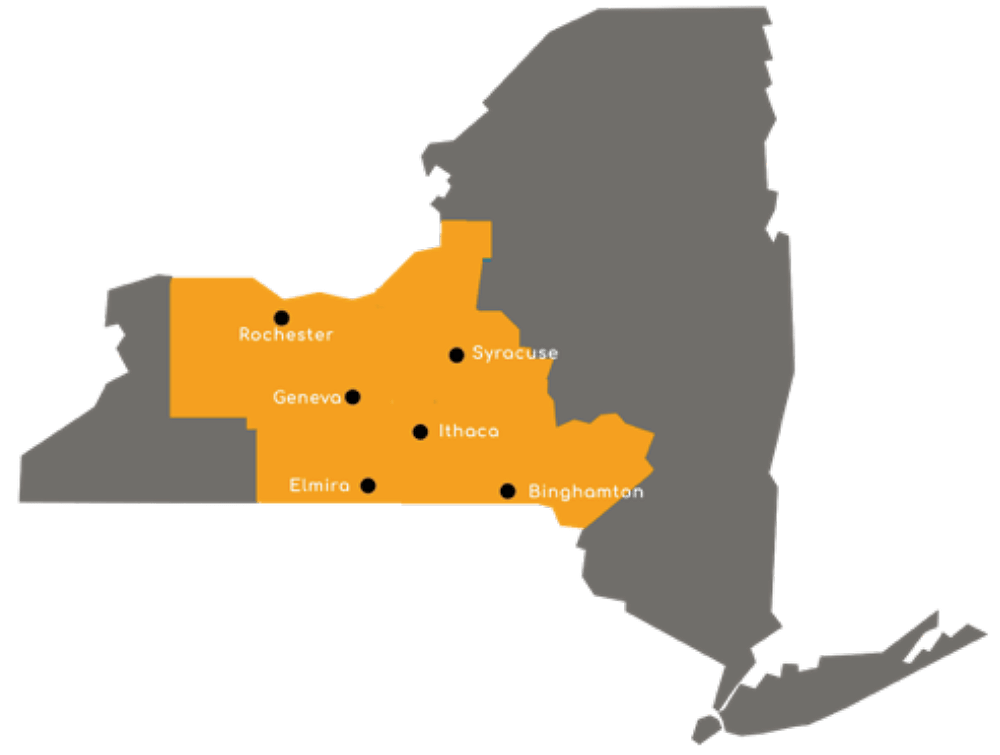Regional Assets
The region hosts 43.7% of the state’s 33,438 farms, according to the USDA National Agricultural Statistics Service’s 2017 Census of Agriculture. Additionally, research institutions across the region help develop and support new agribusiness ventures, like the $237 million dedicated to R&D by Cornell University’s College of Agriculture and Life Sciences in 2018. In 2014, a study found that New York State’s (NYS) agricultural economy contributed $44.8 billion to the state’s overall economy, reflecting both production expenditures and business-to-business transactions from neighboring industries involved in the agricultural economy2.
New York State is a major producer of agricultural products. The New York Farm Bureau reported in 2016 that NYS is a top producer nationwide of dairy products like milk, yogurt and cheese, apples, maple syrup, and grapes, including wine grapes. NYS ranks 3rd nationwide in wine production, after California and Washington state, and ranked 2nd in the country in food processing for 2018 by the USDA Economic Research Service. NYS is also advancing industrial hemp research and innovation by investing over $10 million in grant funding* for researchers and processors. Geneva, NY, located in the Finger Lakes, is the location of the nation’s first industrial hemp seed bank.
*Correction: an email distributed by the CREA team on March 10, 2020 incorrectly stated that NYS invested over $20 million in grant funding in hemp research and innovation. The correct figure is $10 million.
Employment in Food and Ag
The Grow-NY region employs a third of all food and ag sector workers in the state, approximately 27,724 people. It is cumulatively home to the largest number of jobs in the food and agricultural sectors, with the Finger Lakes region alone ranking second only to New York City in 2018 (see Fig. 1).
Figure 1. Employment in food and agriculture by region
The food and agricultural sector is projected to keep adding jobs through 2026, according to NYSDOL labor analysts, notably in the area of food and beverage manufacturing.
Figure 2. Average annual employment in the Grow-NY region.
Food and Beverage Manufacturing is Growing Fast
The USDA Economic Research Service ranked NYS second in the country in food processing in 2018. NYSDOL data shows that the Grow-NY region is contributing to the state’s growth in the food and beverage processing industry. Since 2009, the industry has grown by 33 percent, making it competitive with regions closer to New York City like the Hudson Valley. In 2018, the Grow-NY region employed 16,447 people in the food and beverage manufacturing, second only to New York City. The Finger Lakes alone is home to the largest beverage industry in the state, with 2,586 jobs, and New York state labor analysts expect the Grow-NY region to continue adding jobs in food and beverage through the next decade.
Figure 3. Food and beverage manufacturing employment in the Grow-NY region
Figure 4. Food and beverage manufacturing employment in Grow-NY region, by industry
What is food manufacturing?
Food manufacturing includes all processes involved in turning animal and plant products into consumer goods, like turning milk into cheese, or wheat into bread, but excludes growers and farmers.
Food manufacturing has seen more and more smaller players enter the market, like small production vineyards, or artisanal cheese producers. The Grow-NY region is no different. In fact, its history of agriculture and dairy production has made it a favorite of major, multi-national brands like Kraft-Heinz and Barilla, even as small producers multiply. Kraft-Heinz and Barilla both have established plants in Avon, NY (Livingston County). The Grow-NY region is also home to Chobani, a maker of yogurt with an annual revenue of about $1.5 billion, providing more than 1,000 jobs in its Chenango County manufacturing facility.
In addition to the household names, Grow-NY is dotted with contract manufacturers and co-packers that help packaged food and beverage brands produce and package their finished products. LiDestri, headquartered in Rochester with a plant close by, is one such example.
References:
[1] The agricultural economy is defined here as the following NAICS industry codes: 111 Crop Production; 112 Animal Production and Aquaculture; 113 Forester and Logging; 114 Fishing, Hunting and Trapping; 115 Support Activities for Agriculture and Forestry; 311 Food Manufacturing; and 312 Beverage and Tobacco Product Manufacturing.
[2] See Todd M. Schmit, “The Economic Contributions of Agriculture to New York State,” (2014). Retrieved from http://publications.dyson.cornell.edu/outreach/extensionpdf/2016/Cornell-Dyson-eb1609.pdf
Research contributed by Adi Menayang and Samuel Coons.
Contact [email protected] with questions or more information.
Sign up here if you want to receive future emails with more information like this.







